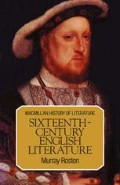Abstract
In the earlier part of the sixteenth century, English literature certainly has its finer moments — the urbane prose of Sir Thomas More, the sonnets of Wyatt and Surrey, and the boisterous comedy of Gammer Gurton’s Needle. Yet nothing within that century can match the surge of creativity which was so brilliantly to mark its final decades. In the brief space of some ten to fifteen years, what had been until then an essentially imitative literature looking towards the continent for its models came suddenly into its own, and the poetry of Sidney and Spenser, Marlowe and Shakespeare not only projected England to the forefront of the European scene, but set new standards against which the drama and poetry of future generations would be judged.
Preview
Unable to display preview. Download preview PDF.
Copyright information
© 1982 Murray Roston
About this chapter
Cite this chapter
Roston, M. (1982). The dual vision. In: Sixteenth-Century English Literature. Macmillan History of Literature. Palgrave, London. https://doi.org/10.1007/978-1-349-27750-6_1
Download citation
DOI: https://doi.org/10.1007/978-1-349-27750-6_1
Publisher Name: Palgrave, London
Print ISBN: 978-0-333-27143-8
Online ISBN: 978-1-349-27750-6
eBook Packages: Palgrave Literature & Performing Arts CollectionLiterature, Cultural and Media Studies (R0)

